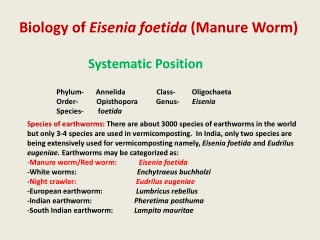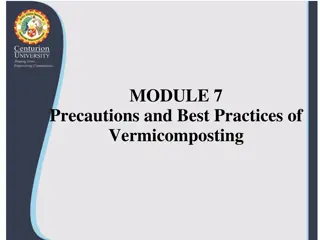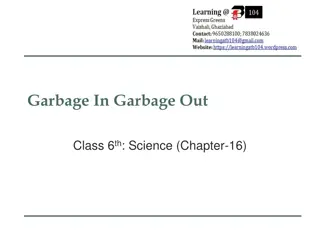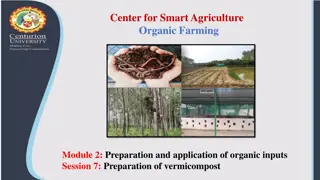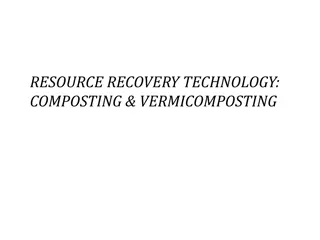Biology of Eisenia foetida (Manure Worm)
Learn about Eisenia foetida, a key earthworm species used in vermicomposting, its identification, ecology, efficiency, and morphology. Discover its burrowing habits, feeding behavior, reproduction capabilities, and environmental preferences for optimal performance in composting.
0 views • 25 slides
Precautions and Best Practices of Vermicomposting
Learn the essential precautions and best practices for successful vermicomposting. Discover the ideal earthworm species, suitable materials, protection methods, watering tips, and post-composting care. Follow temperature, moisture, pH guidelines, avoid certain materials, and maintain proper drainage
0 views • 7 slides
Managing Garbage: A Comprehensive Overview for Class 6 Science
This educational material delves into the science of garbage management, covering topics such as types of garbage, how to deal with garbage, components of garbage, recycling, composting, vermicomposting, and the impact of plastics on the environment and health. It emphasizes the importance of proper
0 views • 14 slides
Sustainable Practices for Protecting Earthworms in Vermiculture Beds
Implementing preventive measures like covering the vermibed with wire mesh, gunny bags, etc., and using neem-based insecticides can safeguard earthworms from predators like birds, ants, rats, and diseases. Following agricultural practices and maintaining favorable environmental conditions are crucia
0 views • 5 slides
Vermicomposting: Organic Farming with Earthworms
Vermicomposting is a sustainable method of converting organic waste into nutrient-rich compost using earthworms. This process involves preparing organic materials, creating a vermi bed, and layering substrates for the worms to decompose. Different earthworm species are utilized for vermicomposting,
0 views • 9 slides
Understanding Composting and Vermicomposting Technology
Composting and vermicomposting are controlled decomposition processes of organic materials, with aerobic microbes breaking down the matter in the presence of oxygen. Aerobic composting produces stable humus and helps eliminate pathogens and weed seeds. The processes involve microbial respiration, ga
1 views • 29 slides
